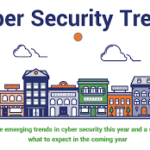With the digital revolution sweeping the globe, big and small corporations, organizations, and even governments are dependent on computerized platforms to handle their day-to-day operations, rendering encryption a top priority to protect data from numerous web threats or unwanted entry. Swooping in to save the day, Cybersecurity plunges forth this year with new innovative trends in the modern era. Cybersecurity experts can be compared to soldiers on the border, preventing or fighting against digital attacks, destruction, and unauthorized entry. They are trained through various cybersecurity courses and CISSP training programmes to enhance their cybersecurity skills. As businesses prepare to enter a new normal in 2023 and beyond, here are some important cybersecurity developments that security departments must be aware of to handle the crisis: Here are the five key Cybersecurity trends in 2023: rather interesting to explore!

Table of Contents
1) The cloud: Not so secure anymore!
As the coronavirus pandemic accelerated remote work and online teamwork, cloud adoption emerged as an ally for companies seeking to maintain business continuity. However, in 2023, you can expect cloud security to be more prone to breaches. Though global companies were transitioning to the cloud before the outbreak, the pandemic accelerated the process. Rapid cloud migration is expected to bring a slew of new security risks and problems. Cloud-based security risks include:
- Misconfigured cloud storage.
- Decreased access and power.
- Insufficient data deletion.
- Cloud-app vulnerabilities will continue to threaten companies in the future.
With all its size and automation, the cloud is still a minefield of misconfiguration land mines that will continue to lead to significant data breaches and security holes. The shift to the cloud necessitates the acquisition of new security skills and the consideration of the entire implementation architecture as part of the implementation and threat simulation processes.
2) AI Inclusion – It’s Terminator time!
When cyberattacks get more intense and frequent, Artificial Intelligence (AI) is poised to assist under-resourced defence teams to stay ahead of the challenges. AI delivers threat analysis by processing vast amounts of risk data from centralized and unstructured tools, reducing the time it takes the security team to make strategic decisions and react to the threat. The arms race will heat up in 2023, with weaponized ML attacks that go beyond constant scanning for vulnerabilities. As companies seek to keep up with AI-powered attackers, emerging defences such as continuous automatic red-teaming (CART) can gain traction. The other side of the coin, on the other hand, allows cybersecurity researchers to breathe a little. Teams can spend less time constructing stable infrastructures from the ground up, starting from a secure point and working their way up. Of necessity, all of the construction must be completed safely.

3) Secure Access Service Edge (SASE) – Trendy indeed!
The coronavirus pandemic has prompted a shift toward remote working, cloud adoption, and online communication, and this pattern is expected to continue. As a result, network security in enterprises is shifting away from LAN-based appliance models and toward cloud-native security application models such as Secure Access Service Edge (SASE). SASE technology allows organizations to robustly protect distributed employees and cloud applications through routing network traffic via a cloud-based security stack. Well, this is a new trend in essence, and cybersecurity experts are already on top of it to learn all specifications!

4) 5G Network: A New Era of Technology and Risks!
The Internet of Things (IoT) with 5G networks is the next raging cybersecurity theme for 2023. With 5G networks set to launch worldwide in 2020, the IoT will usher in a new age of interconnectivity. This contact between different machines exposes them to outside influence, threats, or an unexplained software error. Even the world’s most popular browser, which Google Chrome funds, was discovered to have significant flaws. 5G infrastructure is also relatively new in the market, necessitating extensive testing to identify deficiencies to make the device safer against external attack. Any phase of the 5G network could be dangerous. In this case, vendors must be very cautious when developing advanced 5G hardware and applications to prevent data breaches. Have you recently upgraded to 5G? Beware!
5) Integration and automation
The next cybersecurity development is that, with the scale of data increasing by the day, automation must be implemented and have more advanced control over the information. Current job demands pressure practitioners and engineers to provide fast and effective solutions, making automation more useful than ever. To develop more stable applications in every aspect, security metrics are integrated into the agile process.
Large and dynamic web apps are much more challenging to secure, making automation and cyber defence vital in the software development process.
Remote working has dramatically altered the way multinational companies run amid the pandemic, and the pattern shows no signs of abating. Though the transition to remote working was fast and furious for many organizations, many businesses now realize that ‘work from home is the future of work. Subsequently, new security trends to protect data are also arising to save the day. 2020 has certainly been full of challenges, upheavals, reckonings and uncertainty. With this tumultuous year behind us, 2023 showcases an inevitable innovation surge that may revolutionize the Cybersecurity Industry.









